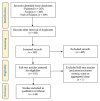What Do We Have to Know about PD-L1 Expression in Prostate Cancer? A Systematic Literature Review. Part 3: PD-L1, Intracellular Signaling Pathways and Tumor Microenvironment
- PMID: 34830209
- PMCID: PMC8618001
- DOI: 10.3390/ijms222212330
What Do We Have to Know about PD-L1 Expression in Prostate Cancer? A Systematic Literature Review. Part 3: PD-L1, Intracellular Signaling Pathways and Tumor Microenvironment
Abstract
The tumor microenvironment (TME) includes immune (T, B, NK, dendritic), stromal, mesenchymal, endothelial, adipocytic cells, extracellular matrix, and cytokines/chemokines/soluble factors regulating various intracellular signaling pathways (ISP) in tumor cells. TME influences the survival/progression of prostate cancer (PC), enabling tumor cell immune-evasion also through the activation of the PD-1/PD-L1 axis. We have performed a systematic literature review according to the PRISMA guidelines, to investigate how the PD-1/PD-L1 pathway is influenced by TME and ISPs. Tumor immune-escape mechanisms include suppression/exhaustion of tumor infiltrating cytotoxic T lymphocytes, inhibition of tumor suppressive NK cells, increase in immune-suppressive immune cells (regulatory T, M2 macrophagic, myeloid-derived suppressor, dendritic, stromal, and adipocytic cells). IFN-γ (the most investigated factor), TGF-β, TNF-α, IL-6, IL-17, IL-15, IL-27, complement factor C5a, and other soluble molecules secreted by TME components (and sometimes increased in patients' serum), as well as and hypoxia, influenced the regulation of PD-L1. Experimental studies using human and mouse PC cell lines (derived from either androgen-sensitive or androgen-resistant tumors) revealed that the intracellular ERK/MEK, Akt-mTOR, NF-kB, WNT and JAK/STAT pathways were involved in PD-L1 upregulation in PC. Blocking the PD-1/PD-L1 signaling by using immunotherapy drugs can prevent tumor immune-escape, increasing the anti-tumor activity of immune cells.
Keywords: PD-L1; cancer; checkpoint inhibitors; immunotherapy; prostate; signaling pathways; target-therapy; tumor microenvironment.
Conflict of interest statement
The authors declare no conflict of interest.
Figures




Similar articles
-
What Do We Have to Know about PD-L1 Expression in Prostate Cancer? A Systematic Literature Review. Part 4: Experimental Treatments in Pre-Clinical Studies (Cell Lines and Mouse Models).Int J Mol Sci. 2021 Nov 14;22(22):12297. doi: 10.3390/ijms222212297. Int J Mol Sci. 2021. PMID: 34830179 Free PMC article.
-
PD-L1 targeting high-affinity NK (t-haNK) cells induce direct antitumor effects and target suppressive MDSC populations.J Immunother Cancer. 2020 May;8(1):e000450. doi: 10.1136/jitc-2019-000450. J Immunother Cancer. 2020. PMID: 32439799 Free PMC article.
-
Therapeutic Implications of Tumor Microenvironment in Lung Cancer: Focus on Immune Checkpoint Blockade.Front Immunol. 2022 Jan 7;12:799455. doi: 10.3389/fimmu.2021.799455. eCollection 2021. Front Immunol. 2022. PMID: 35069581 Free PMC article. Review.
-
Sensitizing tumors to anti-PD-1 therapy by promoting NK and CD8+ T cells via pharmacological activation of FOXO3.J Immunother Cancer. 2021 Dec;9(12):e002772. doi: 10.1136/jitc-2021-002772. J Immunother Cancer. 2021. PMID: 34887262 Free PMC article.
-
Impacts of combining PD-L1 inhibitor and radiotherapy on the tumour immune microenvironment in a mouse model of esophageal squamous cell carcinoma.BMC Cancer. 2025 Mar 14;25(1):474. doi: 10.1186/s12885-025-13801-0. BMC Cancer. 2025. PMID: 40087599 Free PMC article.
Cited by
-
The Role of Anesthetic Drugs and Statins in Prostate Cancer Recurrence: Starting at the Actual Knowledge and Walking through a New Paradigm.Cancers (Basel). 2023 Jun 5;15(11):3059. doi: 10.3390/cancers15113059. Cancers (Basel). 2023. PMID: 37297021 Free PMC article. Review.
-
Programmed Death Ligand 1 (PD-L1) Expression in Lymphomas: State of the Art.Int J Mol Sci. 2024 Jun 11;25(12):6447. doi: 10.3390/ijms25126447. Int J Mol Sci. 2024. PMID: 38928153 Free PMC article. Review.
-
Androgen Insensitivity Syndrome with Bilateral Gonadal Sertoli Cell Lesions, Sertoli-Leydig Cell Tumor, and Paratesticular Leiomyoma: A Case Report and First Systematic Literature Review.J Clin Med. 2024 Feb 6;13(4):929. doi: 10.3390/jcm13040929. J Clin Med. 2024. PMID: 38398243 Free PMC article.
-
Prostate cancer therapy using immune checkpoint molecules to target recombinant dendritic cells.Investig Clin Urol. 2024 May;65(3):300-310. doi: 10.4111/icu.20230348. Investig Clin Urol. 2024. PMID: 38714521 Free PMC article.
-
Molecular Docking and Intracellular Translocation of Extracellular Vesicles for Efficient Drug Delivery.Int J Mol Sci. 2022 Oct 26;23(21):12971. doi: 10.3390/ijms232112971. Int J Mol Sci. 2022. PMID: 36361760 Free PMC article. Review.
References
-
- Falzarano S.M., Ferro M., Bollito E., Klein E.A., Carrieri G., Magi-Galluzzi C. Novel biomarkers and genomic tests in prostate cancer: A critical analysis. Minerva Urol. Nefrol. 2015;67:211–231. - PubMed
-
- Di Donato M., Zamagni A., Galasso G., Di Zazzo E., Giovannelli P., Barone M.V., Zanoni M., Gunelli R., Costantini M., Auricchio F., et al. The androgen receptor/filamin A complex as a target in prostate cancer microenvironment. Cell Death Dis. 2021;12:127. doi: 10.1038/s41419-021-03402-7. - DOI - PMC - PubMed
Publication types
MeSH terms
Substances
LinkOut - more resources
Full Text Sources
Medical
Research Materials
Miscellaneous

